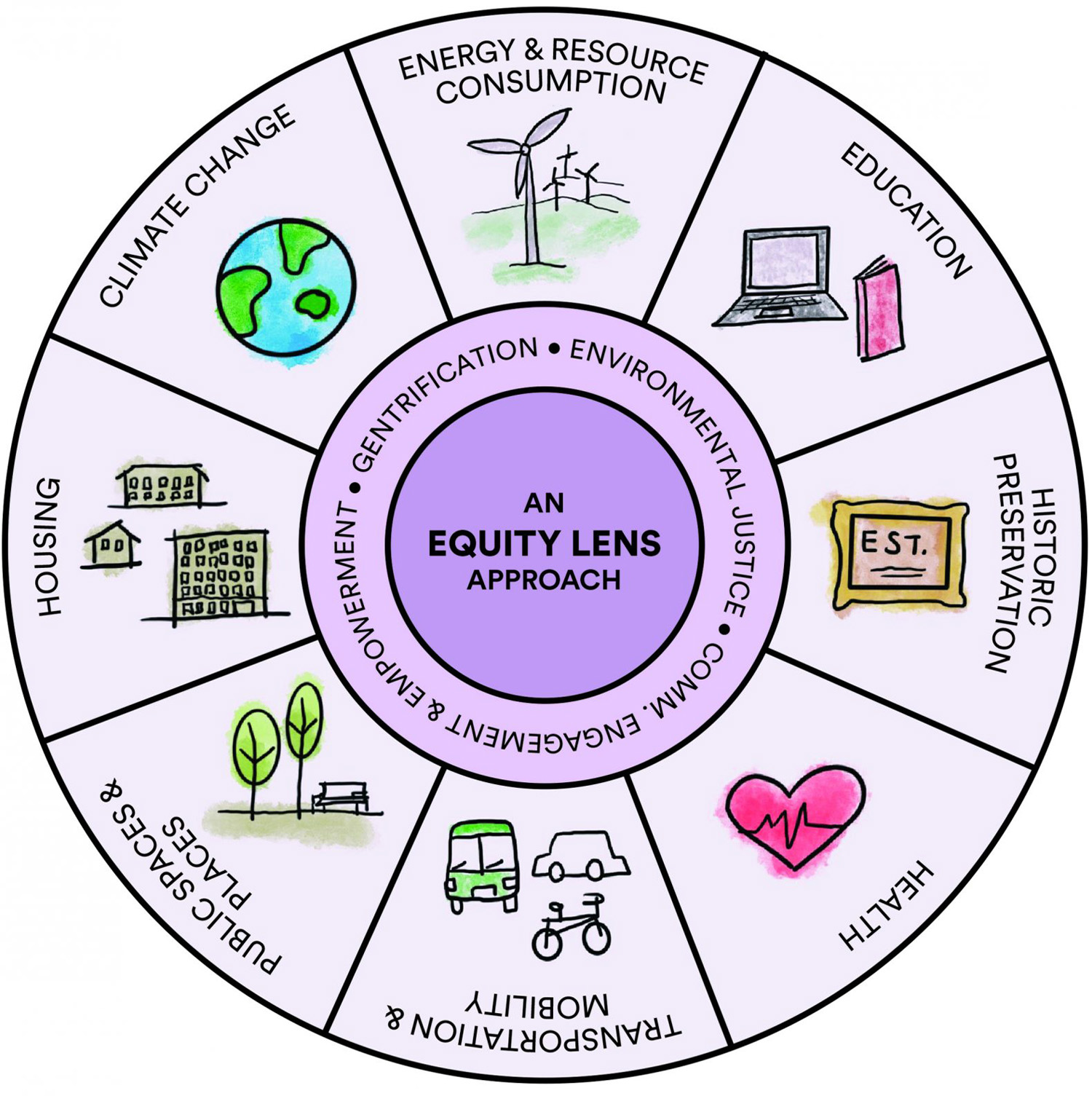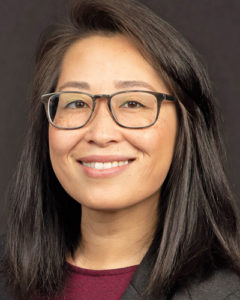By Cindy Ma, AICP
What a year!
2020 delivered a series of events that surfaced long-standing inequities within our society and communities. The confluence of Covid-19, Black Lives Matter, and increased climate-related events such as wildfires and hurricanes, showed that people in marginalized communities, especially those of color, have been for a long time subject to a life of increased stress, risk, and early death.
While 2020 tested our resilience and capacity to adapt, it also provided an opportunity for introspection at the individual and community level of how we, through our actions and inhabitation of our habitats, have strongly affected the inequities in the places we live, work, and play.
I’m a planner and urban designer in a multidisciplinary firm, and I resolved, after the events of 2020, to help create a more equitable world in all aspects of my life. That involved examining and including in my work an “Equity Lens” approach.
The Equity Lens approach, as described by APA’s 2019 publication, Planning for Equity Policy Guide, “challenges … practices and actions that disproportionately impact and stymie the progress of certain segments of the population.” This holistic approach acknowledges the historical context of the inequitable policies and frameworks we’ve inherited and offers guidance on where and how we can challenge ourselves to learn from the mistakes of our past and work to correct them to ensure a future more equitable and inclusive for all.
APA’s guide defines equity as “just and fair inclusion into a society in which all can participate, prosper, and reach their full potential. Unlocking the promise of the nation by unleashing the promise in us all.”

Within the framework of the Equity Lens approach are eight practice focus areas and three crosscutting issues that apply to the eight areas. The eight practice areas are: (1) climate change and resilience; (2) education (the physical location of schools); (3) energy and resource consumption; (4) health equity; (5) heritage preservation; (6) housing; (7) mobility and transportation; and (8) public spaces and places. The policy guide offers key measures to consider in each practice area. With respect to planning, which may take years to implement, the guide suggests ways to bring tangible results in the immediate future.
Under Housing, for example, the guide promotes an increasingly diverse housing stock, removal of regulatory barriers, and a focus on goals promoting affordability and combating displacement. In California, where there is an ongoing housing crisis, state legislation has focused on increasing the housing supply and streamlining the approval processes to ensure implementation. I’ve had the opportunity to work with colleagues, clients, and community stakeholders to get creative in addressing housing affordability, accessibility (universal design), and the longevity and sustainability of structures. Each new development brings different challenges with respect to equity but also offers opportunities to innovate, set new and better precedents, and learn how to do better next time.
More important than the eight practice focus areas are the three crosscutting issues in the Equity Lens approach: (1) Gentrification, (2) Environmental Justice, and (3) Community Engagement and Empowerment.
Gentrification is a process that often results in the displacement of existing residents along with cultural change in an area or community. It is often associated with the actions of development and revitalization. The APA guide emphasizes, “Gentrification is a process, whereas development and revitalization are actions,” and states: “It is important to acknowledge that revitalization executed in the absence of an equity … lens can result in the negative impacts of gentrification, and is a contributing factor to the rising inequality in the nation’s metropolitan areas.”
Environmental Justice is defined by the U.S. Environmental Protection Agency as “fair treatment and meaningful involvement of all people regardless of race, color, national origin, or income with respect to the development, implementation, and enforcement of environmental laws, regulations, and policies.”
Community Engagement and Empowerment is “meaningful [public] outreach to all populations so that all people have a voice and access to decision making.”
All the crosscutting issues center on people, and warrant deep exploration and understanding. And when packaged in an equity framework, they convey the complexity and intersectionality that comes with doing equitable work through transdisciplinary efforts fostered in collaboration and support.
My experience
Delving into the Equity Lens approach, I reflected on my past and current work and life experiences in my habitat — the impact of my actions — from the nucleus home, to the local community, regional area, state, national, and global levels with respect to societal and physical environments. Through this process, I was struck how equitable planning and design recognizes and incorporates the human experience through sound data and research. But for much of the 20th century, development decisions focused largely on scientific data at the expense of the human experience.
Applying all eight focus areas and addressing the three crosscutting issues proposed in the Equity Lens approach will involve mindful listening and sometimes tough conversations. But we can do it, and it will be worth doing.
In some places, it has already been done. Hope SF in San Francisco is an example of a new community created with the components of the Equity Lens approach.
Hope SF is a cross-sector initiative currently transforming four of San Francisco’s public housing sites into three neighborhoods with a mix of housing, retail and office, community services, and facilities. Focused as it is on community development and reparations for its original public housing residents, the initiative is unique among new developments.
The creation of these three neighborhoods comes from four goals and eight guiding principles that speak to the three crosscutting issues of the Equity Lens approach — Gentrification, Environmental Justice, Community Engagement and Empowerment. The four goals are: (1) Build racially and economically inclusive neighborhoods, (2) Recognize the power of residents to lead their communities, (3) Increase economic and educational advancement, and (4) Create healthy communities.
To date, more than 750 new affordable homes have been completed, of which some 500 replaced public housing. Residents of the new homes participated in a Leadership Academy to help them build leadership skills and learn about the development process so they could meaningfully participate onsite at city-synced wellness centers and across the four sites in the three neighborhoods that have opened for residents. Hope SF is expected to be complete in 2035 with a total of 5,300 new homes affordable across all income levels.
Next steps
While 2020 delivered a series of events that surfaced long-standing inequities within our society and communities, I saw the opportunity to reflect and to challenge myself to do better as a citizen and a planner. Reacquainting myself with the Equity Lens approach has shown me a path toward creating better and more equitable design, focused on people and driven by data.
A version of this article previously appeared in EXPAND, the KTGY Magazine.
 Cindy Ma, AICP, is Director, Planning, at KTGY, an international architecture, design, and planning firm with seven offices and 400 employees. She has served on APA California – Northern Section’s Board as Planning Diversity Co-Director since 2012. Ma holds an MCRP from CalPoly SLO and a BA in architecture from UC Berkeley. You can reach her at ms.cindy.ma@gmail.com.
Cindy Ma, AICP, is Director, Planning, at KTGY, an international architecture, design, and planning firm with seven offices and 400 employees. She has served on APA California – Northern Section’s Board as Planning Diversity Co-Director since 2012. Ma holds an MCRP from CalPoly SLO and a BA in architecture from UC Berkeley. You can reach her at ms.cindy.ma@gmail.com.

